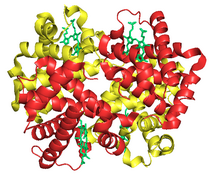| Fetal hemoglobin | ||||||||||||||||
|---|---|---|---|---|---|---|---|---|---|---|---|---|---|---|---|---|
| (4 subunits, α2γ2) | ||||||||||||||||
 | ||||||||||||||||
| Protein type | metalloprotein, globulin | |||||||||||||||
| Function | oxygen-transport | |||||||||||||||
| Cofactor(s) | heme (4) | |||||||||||||||
| ||||||||||||||||
Fetal hemoglobin, or foetal haemoglobin (also hemoglobin F, HbF, or α2γ2) is the main oxygen carrier protein in the human fetus. Hemoglobin F is found in fetal red blood cells, and is involved in transporting oxygen from the mother's bloodstream to organs and tissues in the fetus. It is produced at around 6 weeks of pregnancy [1] and the levels remain high after birth until the baby is roughly 2–4 months old.[2] Hemoglobin F has a different composition than adult forms of hemoglobin, allowing it to bind (or attach to) oxygen more strongly; this in turn enables the developing fetus to retrieve oxygen from the mother's bloodstream, which occurs through the placenta found in the mother's uterus.[3]
In the newborn, levels of hemoglobin F gradually decrease and reach adult levels (less than 1% of total hemoglobin) usually within the first year, as adult forms of hemoglobin begin to be produced.[4] Diseases such as beta thalassemias, which affect components of the adult hemoglobin, can delay this process, and cause hemoglobin F levels to be higher than normal.[5] In sickle cell anemia, increasing the production of hemoglobin F has been used as a treatment to relieve some of the symptoms.[6]
- ^ Linch D (1998). Encyclopedia of Immunology (second ed.). Elsevier. ISBN 978-0-12-226765-9.
- ^ Schechter AN (November 2008). "Hemoglobin research and the origins of molecular medicine". Blood. 112 (10): 3927–38. doi:10.1182/blood-2008-04-078188. PMC 2581994. PMID 18988877.
- ^ Wang Y, Zhao S (2010). "Chapter 2: Placental Blood Circulation". Vascular Biology of the Placenta. Morgan & Claypool Life Sciences.
- ^ Wild B (2017). Dacie and Lewis Practical Haematology (12th ed.). Elsevier. ISBN 978-0-7020-6696-2.
- ^ Sripichai O, Fucharoen S (December 2016). "Fetal hemoglobin regulation in β-thalassemia: heterogeneity, modifiers and therapeutic approaches". Expert Review of Hematology. 9 (12): 1129–1137. doi:10.1080/17474086.2016.1255142. PMID 27801605. S2CID 10820279.
- ^ Lanzkron S, Strouse JJ, Wilson R, Beach MC, Haywood C, Park H, et al. (June 2008). "Systematic review: Hydroxyurea for the treatment of adults with sickle cell disease". Annals of Internal Medicine. 148 (12): 939–55. doi:10.7326/0003-4819-148-12-200806170-00221. PMC 3256736. PMID 18458272.